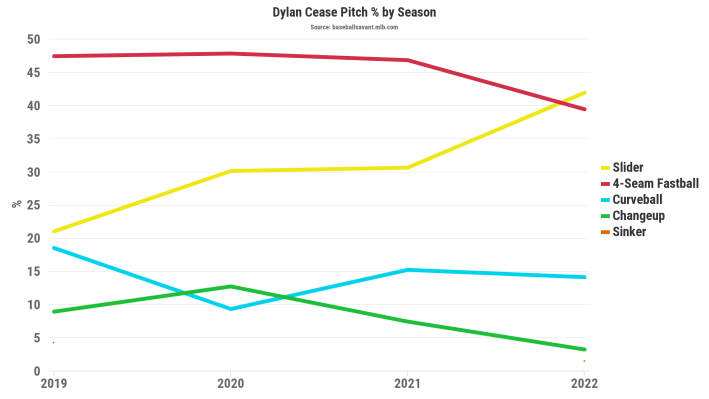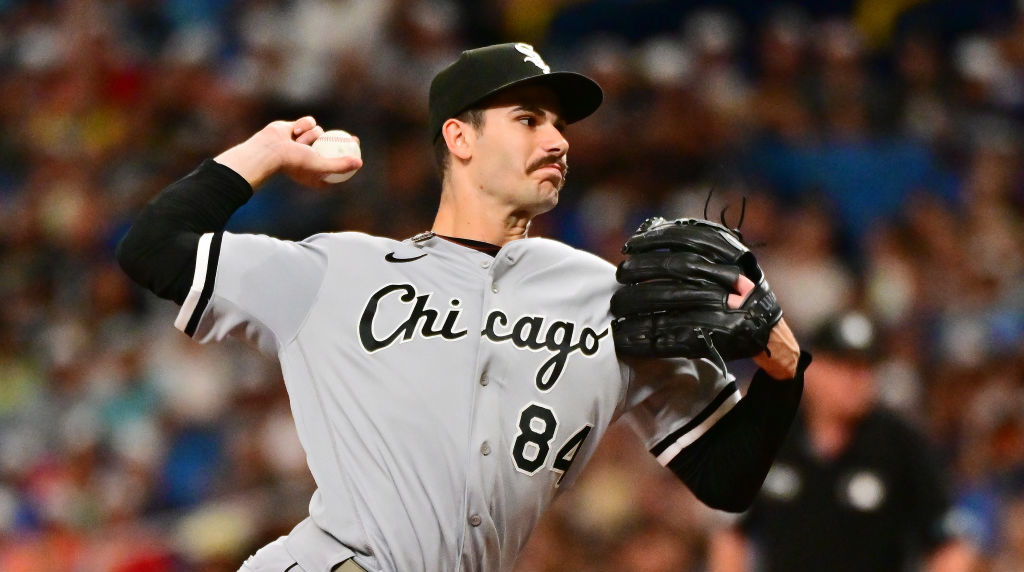This Tuesday, Dylan Cease will face up against Justin Verlander at Guaranteed Rate Field, which is your average AL Cy Young voter's dream match-up. To tally up the statistics that matter, Verlander currently leads MLB with a 1.85 ERA and leads Cease by an inch in fWAR; Cease is right behind him in ERA at 1.95, though he's a half-step above Verlander in rWAR. As for the stat that doesn't matter, Verlander has 15 wins to Cease's 12. In terms of narrative prowess, this is Verlander's first year back from Tommy John; on the exact same tier of comeback story, Cease had a 3.91 ERA last season, when he was the fourth-best pitcher on the White Sox starting rotation. But then the White Sox lost Carlos Rodón to free agency and Lance Lynn to injury and Dallas Keuchel to being irreparably shitty and Lucas Giolito to a broad palette of tragedy. Suddenly there is Dylan Cease as he stands in mid-August, boasting brand new facial hair, which is debatably good, and heading the White Sox rotation with a sub-2.00 ERA, which definitely is.
Going into this Tuesday's game, Cease will try to extend his 14-game streak of starts with with one or fewer earned runs, dating all the way back to May 29th. He is tied with Matt Wisler and Ryne Stanek for the longest such streak in MLB history, though if you require the starter to throw three innings or more in each game, he becomes the only pitcher to accomplish this. Ever. It's longer than Jacob deGrom's 12-game streak in 2021, or Bob Gibson's 11-game streak in 1968 (though Gibson, being Gibson, pitched 17 more innings than Cease), or Christy Mathewson's nine-game streak dating all the way back to when Stathead begins counting in 1901. Cease hasn't necessarily been flawless over this span of time. He allowed 10 additional runs that aren't credited to him, thanks to the early-2022 White Sox defense that would've sent Keith Hernandez to an early retirement, if he were forced to witness it. If you adjust to all runs allowed, the streak falls to 11 and begins on June 14.
Since those quirks of early June, he has been untouchable, often literally. Cease is a paragon of the modern MLB pitcher—he has a high-90s, high-spin fastball with swing-and-miss stuff and boasts ludicrous strikeout rates (12.2 K/9, for those keeping score at home) with middling control. A third of the players facing him strike out, a tenth walk, and it's up to the remaining to actually do anything. So yes, if you lament the general state of offense in baseball, Cease would be Enemy No. 1. You could side-eye lackadaisical foreign substances checks by umpires which might result in a fastball spin graph that looks like this, or flame hitters like Joey Gallo even though the poor man's been through enough already this season, or otherwise find sadness in Cease's success. Verlander's also got the spinny fastball and the strikeouts, but at least he's not walking anyone, dear god.
But look at all those numbers—the spin, strikeout, walk, and whiff rates—and you'll find that they've barely changed from yesteryear. He has marginally more strikeouts and walks, but his strikeout-to-walk ratio is virtually the same. His average spin is actually lower than last year's. The whiffs on his fastball have gone up a bit; the whiffs on his slider have gone down. None of that explains the nearly 2.00 ERA gap between then and now. Perhaps it's his attitude. Cease has always been stoic on the mound, but he walked out this season looking like an extra off the set of Peaky Blinders, and that has to mean something. More likely, it comes down what happens in the 57 percent of times that someone does end up making contact and—to move the discussion out of the realm of the four-seamer—what he does with his slider.
In the age of launch angles and "just hit the ball hard, duh," Cease has improved in the contact metrics that matter. Hitters are no longer elevating the ball as much—they averaged an 18.5-degree launch angle in 2021, but average only 13 degrees in 2022. Fewer balls are being hit off the sweet-spot of the bat. He shaved two miles-per-hour off his average exit velocity, dropping his hard-hit percentage—percentage of balls hit with an exit velocity over 95 mph—by about six percent. And all that helps his percentage of barrels, or barreled balls—the platonic ideal of contact with an exit velocity over 98 mph within a certain range of launch angle, a precise definition that might surprise you in baseball as in real life (42 gallons)—drop to 6.4 percent from the 9.9 percent it was last season.
Cease's slider might not explain all of that, but it explains a lot of it, not to mention that it's one of the most intriguing parts of watching him pitch. The wOBA, a catch-all offensive metric, against his fastball has remained much the same from yesteryear, while his curveball and changeup have performed worse. But Cease's very spinny slider now sits at a velocity of 87.2 mph, a fair mark better than last year's 85.9 mph. As mentioned in James Fegan's early June blog about the changes Cease made to his slider, the uptick in velocity for breaking balls is huge. The average vertical movement on Cease's slider may have become less extreme from -38 inches to -36 inches, but if you're able to throw a breaking ball above 85 mph, the profile of the pitch itself matters significantly less; if you're able to maintain much of the movement on your pitch while still increasing the velocity, as Cease has, you'll be unstoppable.
Hitters are batting .121 and slugging .174 against Cease's slider for an overall wOBA of .170. Clearly, he wasn't satisfied by last year's slider wOBA of .238, which is for plebian pitchers with 3.91 ERAs who aren't contending for a Cy Young. And it's not just that his slider's stuff is great, which it is, or that batters can't hit it, which they can't, but that he's using it all the time. Pitchers usually adjust their repertoires after more time in the league. As the quintessential slider-fastball example, Clayton Kershaw has turned to his slider as his primary pitch since 2020, after his fastball began losing velocity. Tom Tango's been on the "sliders are the best pitch in baseball" train for a bit now, and Cease—who hasn't lost velocity on his fastball, but is throwing his slider more anyway—is riding that train to great success. Which is how you end up with a pitch percentage graph that looks like this:

Dylan Cease has taken the Clayton Kershaw route of throwing his slider so much that it's no longer a secondary pitch at all. And why not? If it's your best pitch, throw it more. After all, that's also how you get the most value out of it. Run value is a cumulative statistic that adds up, per pitch, how many runs you save based on change in run potential (for a more elaborate explanation, see here). By this metric, Cease's slider, which has saved a total of -31, is the best pitch in baseball by far.
The Cease-Verlander match-up should be a brilliant display of pitching. By nature of hype in baseball, it also has a good chance of becoming an all-out slugfest. Barring the extremely unlikely, the match-up shouldn't define the AL Cy Young race, or become a turning point in either team's season come playoff time, where the White Sox are currently hovering on the cusp of admission. But Dylan Cease, and his slider, might.






